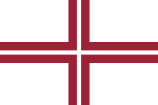Flag of Latvia
 |
|
| Use | Civil and state flag, civil ensign |
|---|---|
| Proportion | 1:2 |
| Adopted | 20 January 1923 Restored on 27 February 1990 |
| Design | A carmine field bisected by a narrow white stripe (one-fifth the width of the flag) |

Variant flag of Latvia
|
|
| Use | Naval ensign |
| Proportion | 2:3 |
| Adopted | 1991 |
| Design | White field with cross voided in the colors of the State Flag (the width of the arms of the cross is 1/5 of the flag width). |
The national flag of Latvia was used by independent Latvia from 1918 until the country was occupied by the Soviet Union in 1940. Its use was suppressed during Soviet rule. Shortly before regaining its independence, Latvia re-adopted on 27 February 1990 the same red-white-red flag.
Though officially adopted in 1923, the Latvian flag was in use as early as the 13th century. The red colour is sometimes described as symbolizing the readiness of the Latvians to give the blood from their hearts for freedom and their willingness to defend their liberty. An alternative interpretation, according to one legend, is that a Latvian leader was wounded in battle, and the edges of the white sheet in which he was wrapped were stained by his blood. The white stripe may stand for the sheet that wrapped him. This story is similar to the legend of the origins of the flag of Austria.
The red-white-red Latvian flag (German: die banier der Letten ) was first mentioned in the chapters of the Rhymed Chronicle of Livonia (Livländische Reimchronik). This historical evidence places the Latvian flag among the oldest flags in the world. The chronicle tells about a battle that took place around 1279, in which ancient Latvian tribes from Cēsis, a city in the northern part of Latvia, went to war, bearing a red flag with a white stripe.
A legend refers to a mortally wounded chief of a Latvian tribe who was wrapped in a white sheet. The part of the sheet on which he was lying remained white, but the two edges were stained in his blood. During the next battle the bloodstained sheet was used as a flag. According to the legend this time the Latvian warriors were successful and drove the enemy away. Ever since then Latvian tribes have used these colours.
Based on the aforementioned historical record, the present day flag design was adapted by artist Ansis Cīrulis in May 1917. The Latvian national flag, together with the national coat of arms was affirmed in this format by a special parliamentary decree of the Republic of Latvia passed on 15 June 1921.
During the period of occupation by the Soviet Union (and briefly by Nazi Germany), the red-white-red Latvian flag was rendered useless from 1940-1941 and 1944-1991. Any production and public display of the nationalist Latvian flag was considered anti-state crime and punishable by law. The first flag was a red flag with the gold hammer and sickle in the top-left corner, with the Latin characters LPSR (Latvijas Padomju Sociālistiskā Republika) above them in gold in a serif font. Starting in 1953, the final version of the flag was adopted. It depicts the Soviet flag with six 1/3 blue wavy bands representing the sea on the bottom.
...
Wikipedia
